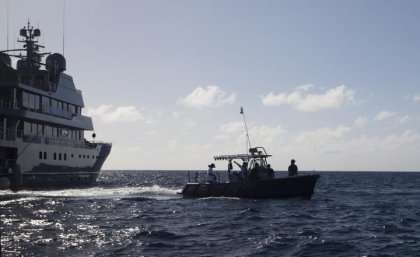Return to the Great Barrier Reef

As part of the shallow and deep reef teams' last deployment for 2014, we have just finished re-visiting sites on the Great Barrier Reef that we first surveyed back in October 2012. In partnership with the Waitt Foundation, the team has spent 14 days surveying 14 remote and spectacular coral reefs from Cairns to the far north sections of the Great Barrier Reef. This is a key milestone achievement for the project as it is the first time we have re-surveyed sites with the SVII camera in order to monitor changes over time. We achieved all of our goals for this trip with the shallow team successfully surveying 32 sites at 14 reefs across 59kms.
Assessing the health of the reef
The deep team photographed 18 of their long-term monitoring plots and retrieved all 21 temperature loggers that were deployed in 2012. This long-term data is providing us with major insights into thermal regimes (ranges of underwater temperatures) and to what extent certain temperatures and conditions can act as a refuge for coral in the face of changing climate. In addition, the deep team collected samples for their ongoing biodiversity and connectivity work.
One of our objectives for the trip was to examine the impact of severe Tropical Cyclone Ita which struck the region in April of this year. Both the shallow and deep teams observed impacts from the cyclone with some parts of the reef quite damaged including sections smashed, and rubble transported, however other parts of the reef showed no evidence of damage. The data gathered on this trip is yet to be fully analysed but will help to explain this varied pattern of damage on the reef.
A successful expedition
Also on this trip we were joined by Andy Durrant, a specialist robotics engineer from the Australian Centre for Field Robotics who used a customised camera rig to capture three-dimensional images of the sea floor. These images will provide crucial information on the structural complexity of the reef and its value as a habitat for marine life.
The entire team was thrilled to be back on the Great Barrier Reef and to witness first-hand the diverse environment from the south to the wild north. Right from our very first dive on Ruby Reef we were quickly reminded of the wildness of the Great Barrier Reef when we encountered a chunky three-metre bull shark, a school of barracudas and two good-looking Bolbometopon muricatum (bump-headed parrotfish) on our way up. This pretty much set the theme of the trip, with the many wildlife encounters including a hammerhead, tigershark, a dugong, and many inquisitive grey and silver tip reef sharks.
The Waitt Foundation's research crew and vessel provided the ultimate science platform for us to exceed our research expectations and goals on all levels, despite undertaking a highly technically challenging operation under sometimes challenging weather conditions. The vessel provided the facilities to have the shallow and deep teams independently deployed throughout the day, with great tenders and a very experienced, friendly and warm crew for whom no job was too big or hard, and no request too much. The crew were always thinking one step ahead of time to ensure that operations proceeded as smoothly and as safely as possible.
Provided by University of Queensland


















